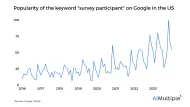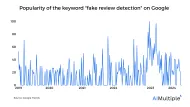In-Depth Guide into Ad Survey in 2024
Are you looking to evaluate the success of your advertising campaign? Understanding how your target audience perceives your ads is crucial for gauging their impact. Advertising effectiveness surveys are a vital tool for businesses aiming to measure this response.
In this article, we’ll explore how an ad survey can provide invaluable insights into the effectiveness of your ad campaigns, helping you fine-tune your marketing strategies and achieve better engagement with your audience.
What is an ad survey?
Ad survey, also known as ad testing, is an efficient method to measure the effectiveness of your ad campaign on your target market or target customers. Companies usually show their ad campaigns to the survey respondents, and they rate how much they like the ad, the improvement areas, and their purchase intent.
Why is the ad effectiveness survey important?
1- Assessing the impact on consumer purchasing decisions
One of the most significant aspects of ad surveys is understanding how an advertisement influences potential customers’ intentions to purchase. This part of the survey asks respondents about their likelihood of buying the product or service after watching the ad. Insights into purchase intent are critical for companies to predict sales trends and assess the direct impact of their advertising efforts on revenue generation.
You can also conduct A/B testing through surveys and show half of the survey participants one version and the other half another version of the ad and measure which one is preferred more.
Source: Cin71
Figure 1. Example of an A/B testing process
2- Pinpointing enhancement opportunities in ad content
A key objective of ad surveys is to identify specific elements within an advertisement that might be underperforming or negatively impacting viewer perception. Survey participants provide feedback on aspects of the ad that could be confusing, less appealing, or irrelevant. This feedback is invaluable for making targeted improvements to the ad, ensuring that it effectively communicates the intended message and resonates better with the audience.
3- Refining marketing strategies for better outcomes
Ad surveys play a pivotal role in enhancing overall marketing strategies. The feedback obtained from these surveys helps companies to tailor their future advertisements more effectively to their target audience. This leads to more strategic and efficient use of marketing budgets, improved targeting, and an overall better return on investment. The ability to optimize marketing efforts based on direct consumer feedback is a significant advantage in a competitive market.
4- Bolstering the brand’s public perception
Ensuring that advertisements contribute positively to a brand’s overall image is another vital aspect of ad surveys. These surveys help in understanding how an advertisement aligns with the company’s values and public image. Positive reception of an ad not only enhances brand loyalty but also strengthens the overall reputation of the company, which is essential for long-term success and sustainability in the market.
6 steps to conduct ad effectiveness surveys
1- Assess current advertising strengths and ad campaign readiness
Prior to deploying any ad effectiveness test, it’s vital for a business to conduct extensive market research to assess its current advertising strengths. This step is about analyzing existing ad campaigns, exploring potential new ad concepts, and aligning them with the company’s core competencies. Utilizing market research at this stage helps ensure the advertising strategy is on the right track, and the business is prepared to launch its ad campaign effectively.
You can check our vendor guide on market research software, if interested.
2- Design a survey template
The success of ad testing hinges on a well-designed survey template that accurately gauges the target audience’s reception of the ad campaign. Researchers should focus on creating questions that probe the effectiveness of the ad message, measuring factors like audience engagement, brand recall, and ad concept clarity. This stage is crucial for gathering real-time insights about the ad’s impact, essential for fine-tuning marketing messages to resonate with the target customers.
For those interested, here is our list of best practices to conduct online surveys.
3- Select a survey platform for optimal and targeted audience reach
Choosing the right platforms for conducting the ad survey is a strategic decision critical for engaging the target group effectively. The selection process should consider which survey platform provides diverse respondents so that you can find a target audience for your ads. This alignment enhances the chances of collecting meaningful feedback that accurately reflects the advertising campaign’s influence on the intended market.
If you are looking for a participant recruitment tool, check out our vendor’s guide.
4- Employ diverse data collection methods
Employing various data collection methods is key to obtaining a comprehensive view of the ad’s effectiveness. This approach allows for a multi-faceted analysis of brand performance, audience preferences, and purchase intent. Ensuring the integrity and accuracy of this data is paramount, as it forms the foundation for assessing the overall impact of the advertising efforts.
5- Analyze survey data
The thorough analysis of survey data is essential for understanding the effectiveness of the ad campaign. Researchers must delve into the feedback, using both quantitative and qualitative methods to extract deep insights into the ad’s performance. This analysis helps identify how well the ad resonated with the target audience and whether it successfully delivered the desired message.
If you are looking for a survey analysis tool, here is our benchmark on the available platforms in the market.
6- Communicate survey findings
Presenting the findings from the ad survey in a clear and actionable manner is crucial for informing future advertising strategies. This involves translating complex data and insights into understandable information that can guide decision-making. It’s about ensuring that the company’s future ad campaigns are better aligned with consumer expectations and market trends.
What are examples of ad survey questions?
There are various types of survey questions that can be embedded in an ad survey. Here we list some of them:
1- Media element
You can incorporate media elements into surveys regarding your ad. For instance, below is an example of an ad survey presenting a choice between two different advertisements for a product called “Chew Bamboo,” asking respondents to select the one they prefer. Each ad highlights a unique selling point of the bamboo toothbrushes, one focusing on a pain-free experience with “No splinters, just smiles,” and the other emphasizing the product’s natural quality for “cleaner teeth.”
Source: Pollfish2
Figure 2. Example of survey question with a media element
2- Open-ended
You can ask respondents to watch an ad and evaluate it with open-ended questions. This will give you qualitative data that involves various insights regarding customers’ preferences. For instance, below is an example of an ad survey question soliciting open-ended feedback, asking respondents to describe the brand with 3-5 adjectives after viewing the advertisement, aiming to capture the brand’s perception and impact.
Source: Survio3
Figure 3. Example of an open-ended ad survey question
3- Checkboxes and Likert scale
You can ask your respondents to select the most associated word with your brand and focus on these features in your ads. Besides, you can understand how they see your brand on a scale from 1-10, and can develop campaigns accordingly. Below are two examples of questions integral to determining the effectiveness of advertising in shaping brand image and customer loyalty.
Source: Attest4
Figure 4. Two examples of survey questions for gaining insights for ad campaigns
If interested, here is our data-driven list of survey participant recruitment services.
For those interested, here is also our data driven list of market research tools.
If you need help in the vendor selection process, don’t hesitate to contact us:
External Links
- 1. “A/B Testing“. Cin7. Retrieved January 10,2024.
- 2. “How To Use Consumer Surveys For Ad Effectiveness“. Pollfish. Retrieved January 10,2024.
- 3. “How to Create Advertising Effectiveness Survey“. Survio. Retrieved January 10,2024.
- 4. “100 Great Survey Questions and Examples“. Attest. Retrieved January 10,2024.

Cem is the principal analyst at AIMultiple since 2017. AIMultiple informs hundreds of thousands of businesses (as per Similarweb) including 60% of Fortune 500 every month.
Cem's work has been cited by leading global publications including Business Insider, Forbes, Washington Post, global firms like Deloitte, HPE, NGOs like World Economic Forum and supranational organizations like European Commission. You can see more reputable companies and media that referenced AIMultiple.
Throughout his career, Cem served as a tech consultant, tech buyer and tech entrepreneur. He advised enterprises on their technology decisions at McKinsey & Company and Altman Solon for more than a decade. He also published a McKinsey report on digitalization.
He led technology strategy and procurement of a telco while reporting to the CEO. He has also led commercial growth of deep tech company Hypatos that reached a 7 digit annual recurring revenue and a 9 digit valuation from 0 within 2 years. Cem's work in Hypatos was covered by leading technology publications like TechCrunch and Business Insider.
Cem regularly speaks at international technology conferences. He graduated from Bogazici University as a computer engineer and holds an MBA from Columbia Business School.
Sources:
AIMultiple.com Traffic Analytics, Ranking & Audience, Similarweb.
Why Microsoft, IBM, and Google Are Ramping up Efforts on AI Ethics, Business Insider.
Microsoft invests $1 billion in OpenAI to pursue artificial intelligence that’s smarter than we are, Washington Post.
Data management barriers to AI success, Deloitte.
Empowering AI Leadership: AI C-Suite Toolkit, World Economic Forum.
Science, Research and Innovation Performance of the EU, European Commission.
Public-sector digitization: The trillion-dollar challenge, McKinsey & Company.
Hypatos gets $11.8M for a deep learning approach to document processing, TechCrunch.
We got an exclusive look at the pitch deck AI startup Hypatos used to raise $11 million, Business Insider.
To stay up-to-date on B2B tech & accelerate your enterprise:
Follow on


Comments
Your email address will not be published. All fields are required.